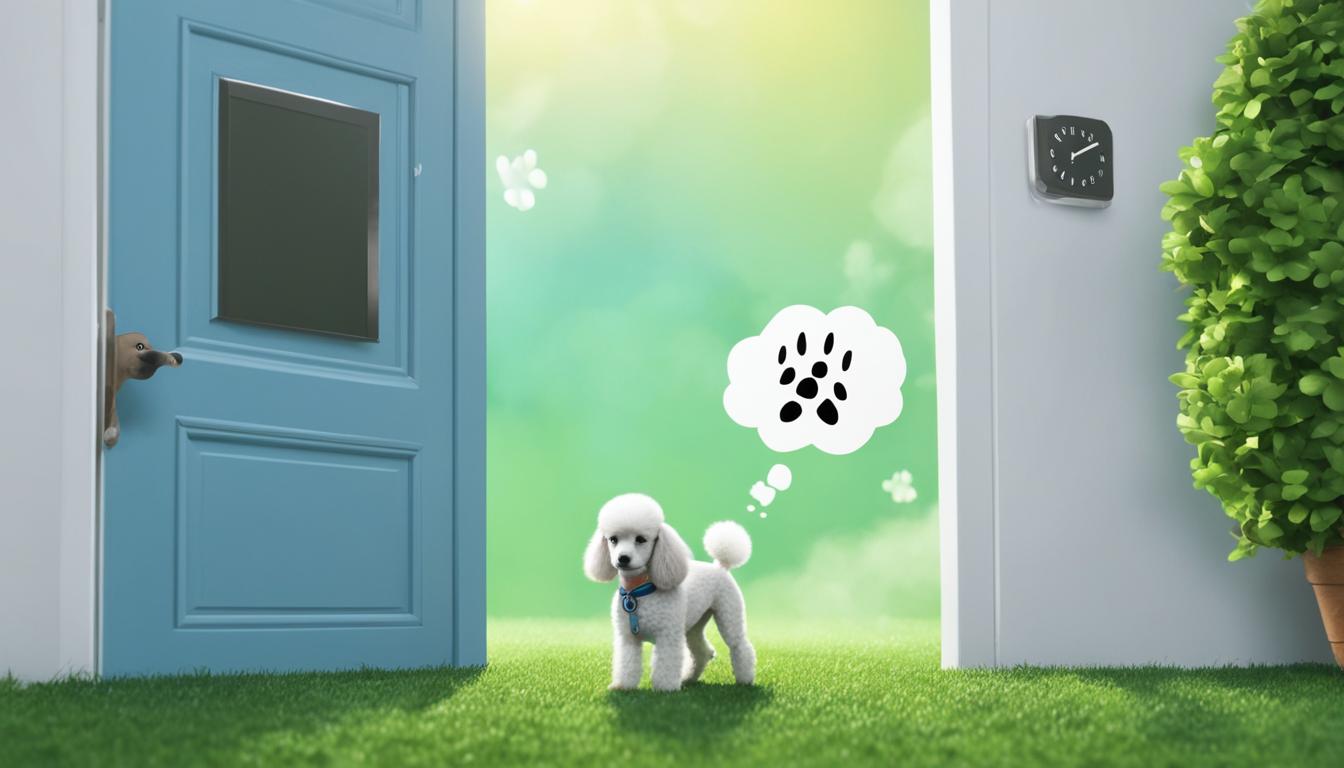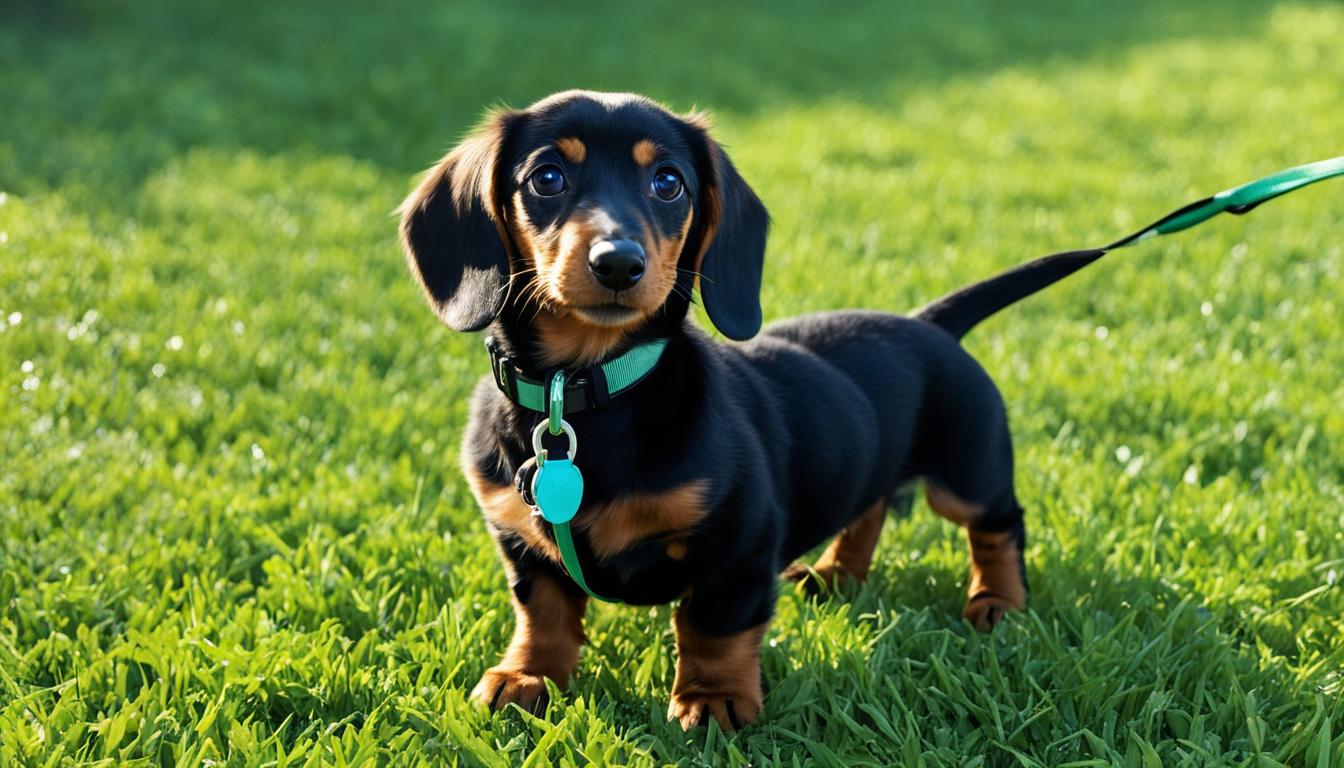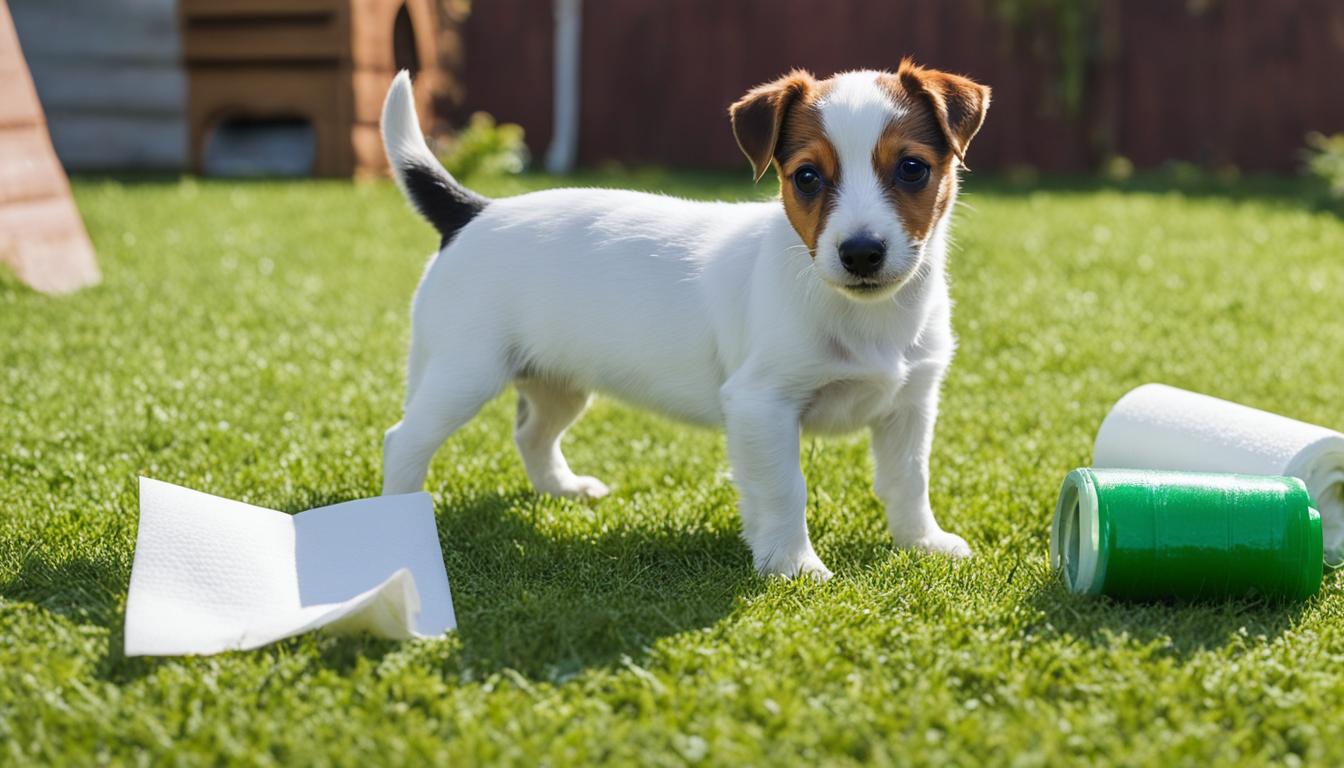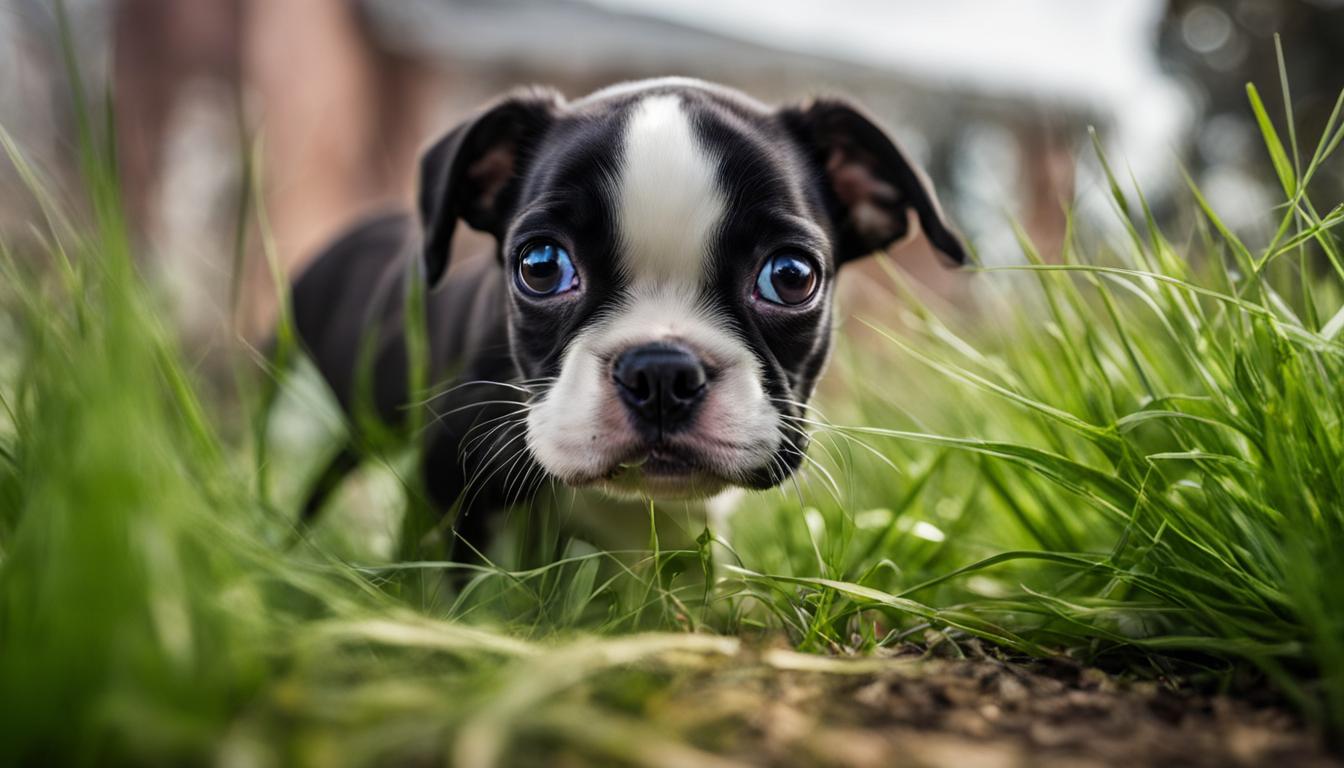Embarking on the journey of housebreaking a puppy can feel like a challenging endeavor, but fear not! With the right potty training plan, you’ll find that teaching your poodle puppy training techniques can be a streamlined and satisfying experience. Here’s how you can set your fluffy companion on the path to potty perfection.
From establishing a routine to praising your pup for a job well done, we’ll guide you through the necessary steps to ensure that your home remains clean, and your poodle becomes well-trained. Let’s dive into the efficient methods and practices that will lead you and your new furry friend to success.
What Are The Benefits of Potty Training Your Poodle Puppy?
Embarking on potty training success with your Poodle puppy isn’t just about keeping your space tidy—it’s about creating a foundational aspect of your relationship that fosters trust and well-being. By investing your time in housebreaking, you are working towards far-reaching benefits that will resonate throughout your puppy’s life.
Let’s consider the substantial benefits of housebreaking. Firstly, it is a proactive step toward preventing the difficult decision of relinquishing a pet due to avoidable household soiling incidents. Additionally, the mental clarity a dog gains from understanding expected behaviors can contribute significantly to a happy puppy demeanor.
| Benefits of Housebreaking | Impact on Poodle Puppy |
|---|---|
| Prevention of behavioral issues | Clear guidelines for bathroom habits reduce stress and confusion. |
| Strengthening the bond | Engaging together in a learning process builds trust and companionship. |
| Health and wellness | Regular potty breaks and a clean environment support physical health. |
| Safety and security | A consistent routine offers a sense of security, leading to a happier, more relaxed pup. |
| Long-term happiness | A well-potty-trained dog is less likely to be given up for adoption. |
By sticking to a consistent schedule and pairing it with a routine of controlled diet and regular exercise, not only are you cementing good bathroom habits, but you are also nurturing your puppy’s overall health and motility. Such a multidimensional approach contributes to both a clean home and a contented, well-adjusted canine companion.
“The joy of a happy puppy is the pinnacle of successful potty training; it mirrors the deep understanding and love shared between you and your pet.”
Remember that rewards play a pivotal role. Reinforcing positive behavior with praise and treats right after your puppy completes a successful potty break accelerates their learning. This form of encouragement not only promotes a desired behavior but also significantly enhances the emotional connection between you and your puppy.
In summary, housebreaking your Poodle puppy encapsulates more than the immediate convenience of a mess-free living environment. It is an investment in your puppy’s future happiness and an essential aspect of a harmonious pet-owner relationship. A happy puppy is the reflection of a committed and loving owner—so revel in each milestone towards potty training success.
How to Potty Train a Poodle Puppy (Step-by-Step)
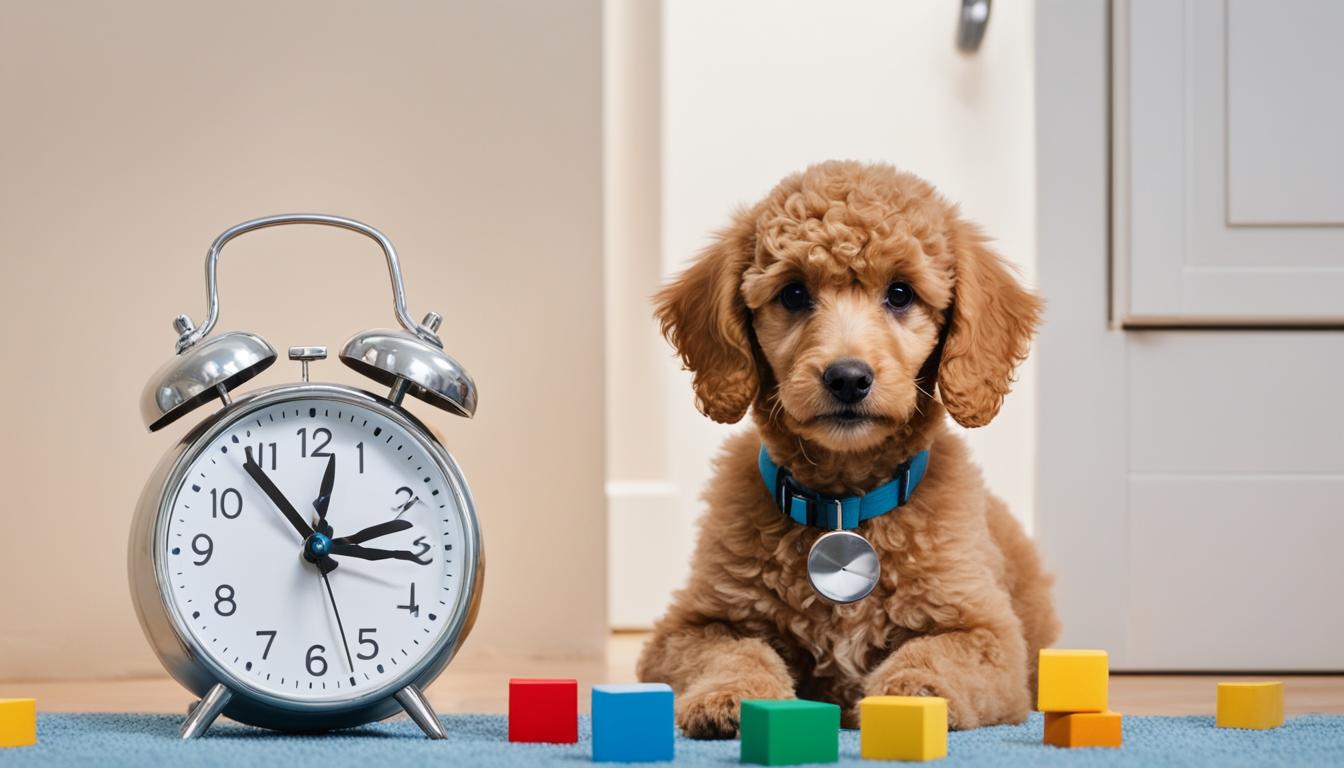
Potty training your poodle puppy doesn’t have to be a daunting task. With a step-by-step approach and the right puppy potty training basics, you’ll be on the path to house soiling prevention in no time. Remember, patience in puppy training is key, and consistency will be your greatest ally throughout this process. Let’s start shaping those positive potty habits and establish an effective housebreaking routine.
Step 1: Master The Basics of Potty Training a Puppy
Understanding the puppy bladder control limitations is the first step. Puppies generally need to relieve themselves frequently—after waking up, eating, playing, and during the night. Establish a puppy potty break schedule to accommodate their needs and to build a consistent potty routine.
Step 2: Choose The Designated Puppy Potty Area
Selecting a designated elimination area is crucial for puppy potty training location consistency. This area should be easily accessible and preferably a quiet spot where your puppy can focus on the task at hand without distractions.
Step 3: Set a Potty Break Schedule
Adhering to a potty training timetable not only helps with structure but also plays into reinforcing a consistent potty routine. Here’s a simple timetable based on age:
| Age | Potty Break Frequency |
|---|---|
| 2-3 months | Every 1-2 hours |
| 3-6 months | Every 2-3 hours |
| 6 months and above | Every 4 hours |
Step 4: Look for Visual Cues Such as Sniffing, Circling, or Whining
Being observant to visual potty cues is essential in puppy potty signal recognition. This will help you to take action before an accident occurs.
Step 5: Take Your Puppy Out to The Designated Potty Area Frequently
Especially in the early stages, frequent potty outings are key to preventing puppy accidents. Over time, as bladder control improves, you can gradually extend the potty intervals.
Step 6: Use a Leash and Collar or Harness to Take The Puppy Outside
Puppy leash training fortifies puppy walking gear familiarity and is vital for outdoor potty training, ensuring the trips are safe and under control.
Step 7: Avoid Accidents at All Costs
Preventing potty accidents comes down to supervision and understanding your puppy’s needs. Employ puppy management techniques such as confining your pet to a smaller space where accidents are easier to clean if they happen.
Step 8: Clean up Any Accidents Thoroughly With an Enzymatic Cleaner
For cleaning puppy accidents, an enzymatic cleaner for dogs ensures that no scent is left behind, which otherwise might encourage your puppy to soil the same area again.
Step 9: Choose a Specific Word to Use Consistently When Taking Your Poodle Puppy Outside to Potty
Employing consistent training commands, like using potty cue words, helps in potty behavior conditioning. Making this a part of your consistent potty routine aids in clear communication.
Step 10: Stick With a Routine
Maintaining a poodle puppy training schedule is necessary for effective housebreaking. Consistency leads to a better understanding and quicker learning for your puppy.
Step 11: Confine The Puppy When You Are Unable to Supervise Them
Puppy confinement methods, like using a puppy pen, are a safe potty training technique when you’re not around to supervise, preventing undesirable incidents.
Step 12: Stay Consistent and Patient for Successful Potty Training
Every puppy’s potty training success story hinges on patience and consistent potty lessons. It’s not about quick fixes but building lasting positive reinforcement.
Step 13: Focus on Praising Your Puppy for Getting It Right
Praise in potty training and rewarding good puppy behavior are your most powerful tools. It’s about reinforcing what’s desired, not punishing the mistakes.
Step 14: Gradually Increase The Time Between Potty Breaks
As your puppy matures, extending potty intervals helps in growing puppy bladder control. But always do this gradually to avoid causing any undue stress or backsliding in training progress.
Equipments You Need Before Starting Potty Training a Poodle Puppy
Gearing up with the right potty training supplies is a pivotal step towards successful housebreaking of your Poodle puppy. Ensuring you have all the puppy training essentials not only facilitates a smoother training experience but also helps to keep your home clean and hygienic. Below is a list of must-have housebreaking gear that you’ll need before initiating the training process.
- Comfortable Collar or Harness: An adequately sized collar or harness that is comfortable for your Poodle puppy will be essential for safety during outdoor potty breaks.
- Hands-Free Leash: A hands-free leash is convenient for constant supervision and tethering when indoors, keeping your puppy close while enabling you to move freely.
- Longer Leash: For outdoor use, a longer leash gives your puppy enough room to find a spot in the designated potty area without feeling restricted.
- Potty Pads/Indoor Dog Litter Boxes: Suitable for indoor training or for moments when outdoor access isn’t feasible, such as during inclement weather.
- Small, Flavorful Treats: Having treats on hand that are irresistible to your puppy will make for effective positive reinforcement during potty training sessions.
- Enzymatic Cleaner: A pet-friendly enzymatic cleaner will be crucial for thoroughly cleaning and deodorizing any areas where accidents may occur.
- Cleaning Tools: These include items like paper towels, a scrub brush, and rubber gloves, essential for addressing accidents promptly and effectively.
With this comprehensive set of equipment, you are now well-equipped to embark on a successful potty training journey with your Poodle puppy. Remember, patience and a consistent routine are just as important as having the right gear. Good luck!
| Equipment | Use Case | Benefits |
|---|---|---|
| Collar/Harness | For secure potty breaks and safe restraint | Ensures puppy safety and assists in control during training |
| Hands-Free Leash | Provides consistent supervision indoors | Convenience for multitasking without ignoring your puppy |
| Longer Leash | Potty breaks in outdoor designated area | Gives puppy freedom to explore while still under control |
| Potty Pads/Indoor Dog Litter Boxes | Controlled indoor training and emergency situations | Prevents accidents on indoor flooring and useful in bad weather |
| Flavorful Treats | Immediate positive reinforcement | Encourages repetition of desired behavior |
| Enzymatic Cleaner | Accident cleanup | Effectively breaks down stains and odors to deter re-marking |
| Cleaning Tools | Handling and disposing of potty accidents | Helps maintain a clean and sanitary home |
Indoor Potty Training Vs. Outdoor Potty Training
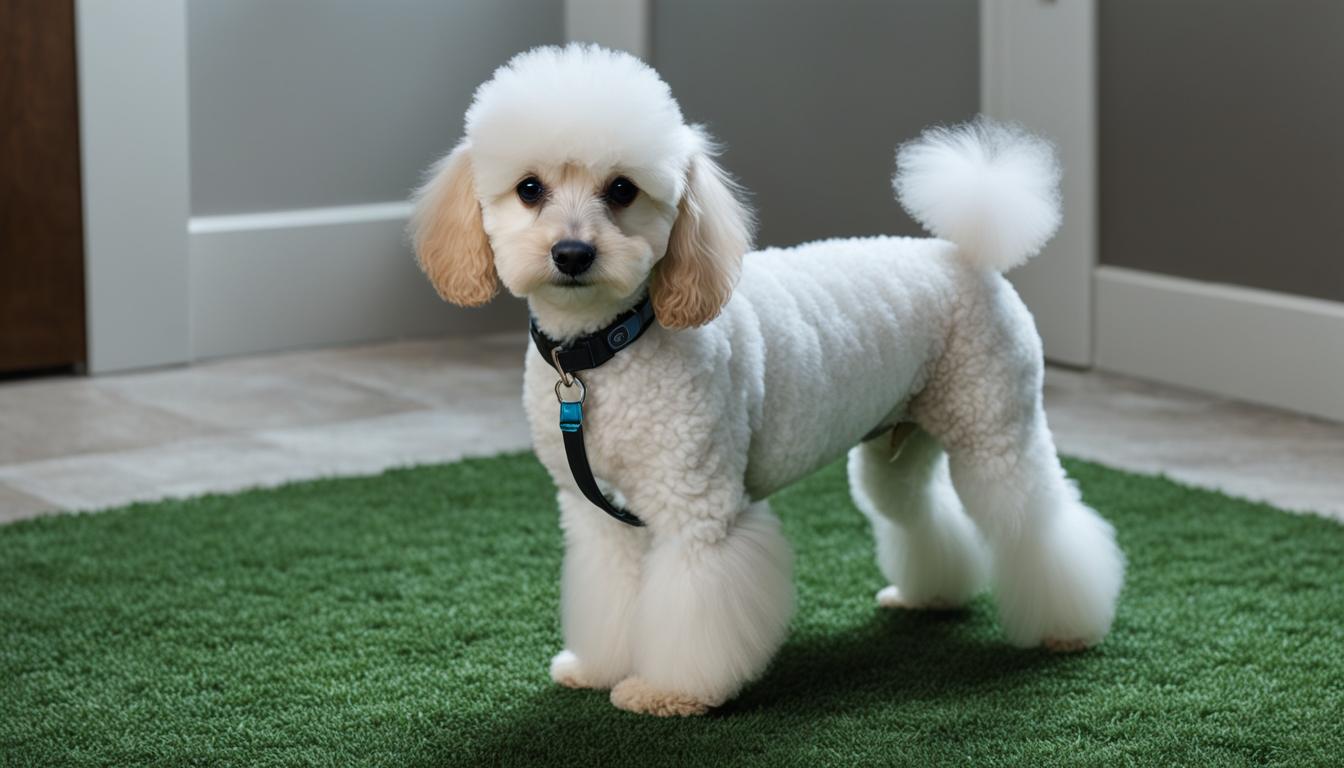
When you’re comparing potty training methods for your poodle puppy, deciding between indoor vs outdoor housebreaking can be challenging. Each method offers advantages tailored to different lifestyles and the specific needs of your poodle puppy. Let’s delve into the factors that might influence whether you decide to opt for an environmentally-controlled indoor option or the more natural outdoor training.
In an indoor setup, potty pads or litter boxes are often used, especially for pet owners with demanding schedules. This approach allows your poodle puppy the convenience of relieving itself without the wait for you to come home for a potty break. Moreover, for those living in high-rise apartments or areas with extreme weather conditions, indoor options guarantee your puppy’s comfort and safety.
On the flip side, outdoor potty training typically aligns with a dog’s instinctual behavior to eliminate outside. This method encourages your poodle puppy to enjoy the fresh air and naturally promotes the preferred potty habits that most owners aim for in the long run. Plus, it gives your furry friend the chance to bask in the sunshine and get a bit of exercise during these breaks.
| Indoor Potty Training | Outdoor Potty Training |
|---|---|
| Ideal for owners with long work hours | Aligns with natural canine instincts |
| Useful in harsh weather conditions | Encourages exercise and outdoor enjoyment |
| Suitable for apartments or no yard access | Can lead to a cleaner home environment |
| May require transition to outdoor as puppy grows | Requires consistent schedule and availability |
Whichever method you choose, understanding the nuances in poodle puppy potty options will help you make an informed decision that best suits your lifestyle and accommodates the needs of your poodle. While comparing potty training methods, always consider your availability, your living environment, and how well each method will integrate into your daily routines.
Crate Training Vs. Pad Training a Poodle Puppy
Choosing the right potty training techniques for your Poodle puppy may seem challenging, but understanding the specifics of each method can help make your decision clearer. Whether you lean towards crate housebreaking or decide on puppy pad use, each technique has its particular benefits that align with different lifestyles and training goals.
| Crate Training | Pad Training |
|---|---|
|
|
| Requires consistent supervision and a strict schedule | May require additional steps to wean off pads |
With crate housebreaking, your Poodle puppy will typically regard the crate as their private space, thus naturally resisting the urge to soil it. This method reinforces bladder and bowel control, and with time, your puppy will learn to hold until you can take them outside. However, it’s crucial to ensure the crate is not used for prolonged confinement, as this can lead to discomfort or anxiety.
On the other hand, puppy pad use offers convenience, especially for those who live in high-rise buildings or work long hours and can’t take their puppies out frequently. Puppy pads can be placed in a dedicated area of your home and can help avoid accidents. Nonetheless, it’s important to eventually transition your puppy from pads to outdoor potty habits if that’s your end goal.
Remember, whether you choose crate training or pad training, consistency is key. You should maintain a regular feeding and potty schedule, and always praise your puppy for good behavior to reinforce these critical potty training techniques.
Frequently Asked Questions About Potty Training a Poodle Puppy
Embarking on house-training your poodle puppy can be an adventure filled with highs and lows. As you navigate the potty training timeline and strive for a well-behaved poodle, you might encounter common obstacles. Let’s tackle some of the frequently asked questions that arise during this important developmental stage, providing you with effective housebreaking options and puppy training duration insights.
How Long Does It Typically Take to Potty Train a Poodle Puppy?
The housebreaking timeframe varies from one puppy to another, influenced by factors like age and prior experiences. Generally, potty training a poodle puppy could range from a few weeks to several months. Puppies usually demonstrate improvements within the first few days, but to achieve a robust potty training routine, you’ll need patience and persistent reinforcement tailored to your furry friend’s growth and learning pace.
What to Do if Your Poodle Puppy Won’t Pee Outside The House?
If your puppy refuses to pee outdoors, this can be assessed and addressed through patience and observation. Look for signs of potty training difficulties or puppy elimination problems. It could be due to hesitation or a sign of anxiety. To assist, create a calm and inviting outdoor potty environment, reduce distractions, and use ample praise and treat-based reinforcement to encourage the behavior.
Should You Use Treats When House Training a Poodle Puppy?
Indeed, rewards for potty training can act as a strong motivational tool. When your puppy completes their business in the desired spot, offering a small, tasty treat immediately afterwards can reinforce positive behavior. This treat-based reinforcement not only motivates puppy behavior but also helps solidify your training efforts, steering clear of potty training errors and common housebreaking pitfalls.
What Are The Benefits of Puppy Potty Training?
The advantages of house training your Poodle puppy extend beyond a sanitary living space. It’s about building trust and a harmonious living situation. A potty trained puppy benefits your household by fostering a stress-free environment, preventing indoor soiling, and ensuring your Poodle’s rightful place within the family dynamic, happily avoiding the consequences of poor potty training.
Is It Better to Use Puppy Pads or Go Straight to Outdoor Potty Training for a Poodle Puppy?
Choosing between puppy pads and outdoor training hinges on potty training preferences, your living situation, and adapting to your Poodle’s needs. While outdoor training complements a dog’s natural preferences, puppy pads can offer a convenient alternative in specific scenarios. Some choose pads initially, with a transition plan toward outdoor training for a smoother potty training experience.
What Should I Do if My Poodle Puppy Does Not Seem to Be Learning to Potty Train Correctly?
When facing poodle puppy training challenges, it’s essential to first rule out medical concerns with a vet. Then, revisit your training techniques, focusing on consistency and clarity. Should issues persist, seeking assistance from a dog training professional may provide the troubleshooting potty training support your Poodle requires.
What Should I Do if My Poodle Puppy Starts Accidents in The House?
When handling puppy accidents, stay composed and reach for an enzymatic cleaner to remove odors properly. Reflect on the situation—was the accident due to a disrupted schedule or missed cues? Use these instances as teaching moments to refine your approach, and remember that preventing indoor soiling is a journey of repeated guidance and adaptation.
What Are Some Common Mistakes That Are Made When Potty Training a Poodle Puppy?
Avoiding puppy training mistakes is tantamount to fostering a successful relationship with your Poodle. Inconsistency, lack of supervision, or improper confinement can deter progress. Additionally, hastily increasing intervals between potty breaks before your puppy is ready can lead to setbacks. Remember, consistent potty breaks, and a well-structured daytime housebreaking schedule are critical.
What Are Some Potential Consequences of Not Potty Training a Poodle Puppy?
Untrained puppy issues can strain the human-animal bond, lead to recurring soiling incidents, and potentially cause behavioral difficulties. The importance of housebreaking cannot be overstated—as it lays the foundation for your puppy’s well-being, ensuring a future as a cherished, lifelong companion.
What Can I Do to Help My Poodle Puppy Feel More Comfortable Going Potty Outside?
To mitigate outdoor potty anxiety, create a distraction-free zone and maintain a calm demeanor during potty trips. Implementing these steps can help your Poodle feel more at ease. Accommodating your puppy’s specific needs while providing consistent positive reinforcement will eventually make outdoor potty breaks a comfortable routine for your pet.
How Old Does My Poodle Need to Be Before I Can Start Potty Training?
Your journey in starting housebreaking can begin as soon as your Poodle puppy settles into their new home, typically around 8 weeks of age. Early introduction to potty training sets the stage for successful habits, even if complete bladder control has yet to mature.
How Often Should I Take My Poodle Puppy Outside to Go Potty During The Day?
Accommodating your puppy’s developing bladder, aim to offer daily potty breaks every 1-2 hours for young puppies. This frequency can be adjusted as they grow older, taking into account their increasing ability for control. Remembering to take your puppy out after waking, meals, and playtime also helps instill a consistent rhythm in your potty training routine.
What Should I Do if My Poodle Puppy Has an Accident Inside During Potty Training?
During potty training setbacks, it’s crucial to remain patient and avoid reprimanding your Poodle puppy. After an accident, thoroughly clean the area and reflect on how to prevent similar incidents in the future. Use accidents as learning opportunities to adjust your approach and enhance the effectiveness of your potty routine.

